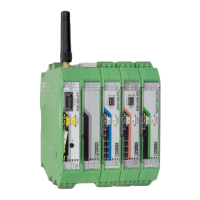Description of I/O extension modules
3827_en_B PHOENIX CONTACT 23/138
Figure 3-9 Systematic temperature measuring error ΔT depending on the cable cross
section A
Figure 3-10 Systematic temperature measuring error ΔT depending on the cable
temperature T
A
(Measuring error valid for: copper cable χ = 57 m/Ωmm
2
, T
A
= 25°C and Pt 100 sensor)
Make sure that the cable resistance and therefore the measuring error is as low as possible.
• Use sensor cables that are as short as possible.
• Avoid conductor cross sections smaller than 0.5 mm
2
.
The temperature has only a small influence on the cable resistance.
You can calculate the cable resistance as follows:
Due to there being two cable resistances in the measuring system, the value must be
doubled. Using the average temperature coefficient α = 0.385 Ω/K for Pt 100, the absolute
measuring error in Kelvin can be determined for platinum sensors according to DIN
standards.
R
L
= R
L20
x [1 + 0.0039
1
x (T
A
- 20°C)]
K
R
L
=
l
x [1 + 0.0039
1
x (T
A
- 20°C)]
χ x A K
R
L
Cable resistance in Ω
R
L20
Cable resistance at 20°C in Ω
l Line length in m
χ Specific resistance of copper in m/
Ωmm
2
A Cable cross section in mm
2
0.0039 1/K Temperature coefficient for copper (degree of purity of 99.99%)
T
A
Ambient temperature (cable temperature) in °C
0 0,1 0,2 0,3 0,4 0,5 0,6 0,7 0,8 0,9 1,0
0
2
4
6
8
10
T [K]
A [mm ]
2
-50 -30 -10 10 30 50 70 90
0
0,5
1
1,5
2
2,5
T [K]
T [°C]

